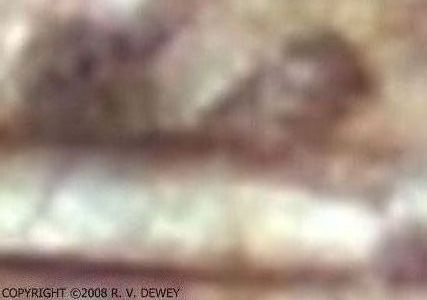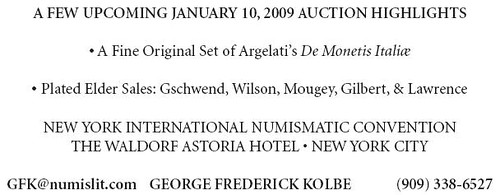
PREV ARTICLE
NEXT ARTICLE
FULL ISSUE
PREV FULL ISSUE
V11 2008 INDEX
E-SYLUM ARCHIVE
MORE ON THE SECRET SIGNATURE OF JAMES B. LONGACRE
I thought I'd get an avalanche of email about R.V. Dewey's image, but readers have been unusually silent. I queried Dennis Tucker who wrote: "I think I might need new spectacles."Author Harold Levi of Blairsville, GA writes:
The image is out of focus and expanded well beyond any
usefulness. If the elements are truly on the coin's surface, then they
should be identifiable by using a microscope to take pictures that are in
focus.
I remain skeptical, but R.V claims he has many other examples of what he believes to be hidden images in coin designs. Until I see them, or others duplicate his results, the jury's out. In this particular photo, I do see what could be the face of a mustachioed man with curly black hair on the right, and what might be a jack-o'-lantern at the left (appropriate for this Halloween season). I suppose I can sort of see a letter "J", but can't make out a JBL.

Is R.V.'s thesis possible? Is it plausible? Is it likely? I rushed out last week's issue, but I've had a week to mull it over and here's what I think. First, I do think it's quite plausible that coin engravers would incorporate some small signature or trademark, and might sometimes conceal their handiwork within some design element. I'm sure our readers could come up with many examples of hidden (or at least non-obvious) traces of engraver whimsy on coins or banknotes. Some have gotten into trouble with their superiors for doing so. Can anyone give us a specific instance (ideally accompanied with an image)?
Is it possible? To be specific, is it really possible that a 19th century engraver could impart an image THAT SMALL on a coin's surface? RV said the photograph "represents an area less then one-quarter square inch on the coin's surface."
R.V.'s image is about four inches across on my screen, a magnification of 16x horizontally. Translating that to square inches is a magnification of 256x (16 x 16). So we're taking an area about a quarter inch on each side and blowing it up to over 250 times its original size.
Doing this on a computer is a digital zoom, not an optical zoom. With a digital zoom clarity is lost. Only an optical zoom (using good lenses) could blow up an image without loss of clarity. So like Harold I'd prefer to see images taken of the coin's surface through a microscope.
So I'm not convinced that there's anything real about what anyone "sees" in these images. Besides, people smarter and more detail-oriented than me have been peering at coins with high magnification for decades. If such tiny signatures exist, is it possible they have been completely unnoticed until now? Possible perhaps, but I don't think likely. Still, I'll look forward to seeing other images and learning what E-Sylum readers think.

Wayne Homren, Editor
The Numismatic Bibliomania Society is a non-profit organization promoting numismatic literature. See our web site at coinbooks.org.
To submit items for publication in The E-Sylum, write to the Editor at this address: whomren@gmail.com
To subscribe go to: https://my.binhost.com/lists/listinfo/esylum
All Rights Reserved.
NBS Home Page
Contact the NBS webmaster
